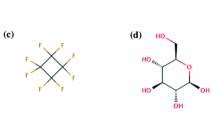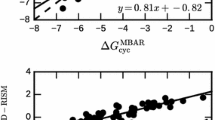Abstract
Here, we test a method, called semi-explicit assembly (SEA), that computes the solvation free energies of molecules in water in the SAMPL4 blind test challenge. SEA was developed with the intention of being as accurate as explicit-solvent models, but much faster to compute. It is accurate because it uses pre-simulations of simple spheres in explicit solvent to obtain structural and thermodynamic quantities, and it is fast because it parses solute free energies into regionally additive quantities. SAMPL4 provided us the opportunity to make new tests of SEA. Our tests here lead us to the following conclusions: (1) The newest version, called Field-SEA, which gives improved predictions for highly charged ions, is shown here to perform as well as the earlier versions (dipolar and quadrupolar SEA) on this broad blind SAMPL4 test set. (2) We find that both the past and present SEA models give solvation free energies that are as accurate as TIP3P. (3) Using a new approach for force field parameter optimization, we developed improved hydroxyl parameters that ensure consistency with neat-solvent dielectric constants, and found that they led to improved solvation free energies for hydroxyl-containing compounds in SAMPL4. We also learned that these hydroxyl parameters are not just fixing solvent exposed oxygens in a general sense, and therefore do not improve predictions for carbonyl or carboxylic-acid groups. Other such functional groups will need their own independent optimizations for potential improvements. Overall, these tests in SAMPL4 indicate that SEA is an accurate, general and fast new approach to computing solvation free energies.



Similar content being viewed by others
Reference
Fennell CJ, Kehoe C, Dill KA (2010) Oil/Water transfer is partly driven by molecular shape, not just size. J Am Chem Soc 132:234–240
Fennell CJ, Kehoe CW, Dill KA (2011) Modeling aqueous solvation with semi-explicit assembly. Proc Natl Acad Sci USA 108:3234–3239
Jorgensen WL, Chandrasekhar J, Madura JD, Impey RW, Klein ML (1983) Comparison of simple potential functions for simulating liquid water. J Chem Phys79:926–935
Fennell CJ, Dill KA (2011) Physical modeling of aqueous solvation. J Stat Phys 145: 209–226
Kehoe CW, Fennell CJ, Dill KA (2012) Testing the semi-explicit assembly solvation model in the SAMPL3 community blind test. J Comput Aided Mol Des 26:563–568
Jorgensen WL, Maxwell DS, Tirado-Rives J (1996) Development and testing of the opls all-atom force field on conformational energetics and properties of organic liquids. J Am Chem Soc 118:11225–11236
Wang J, Wolf RM, Caldwell JW, Kollman PA, Case DA (2004) Development and testing of a general amber force field. J Comput Chem 25:1157–1174
Jakalian A, Bush BL, Jack DB, Bayly CI (2000) Fast, efficient generation of high-quality atomic charges. AM1-BCC model: I. Method. J Comput Chem 21:132–146
Jakalian A, Jack DB, Bayly CI (2002) Fast, efficient generation of high-quality atomic charges. AM1-BCC model: II. Parameterization and validation. J Comput Chem 23:1623–1641
Nicholls A, Mobley DL, Guthrie JP, Chodera JD, Bayly CI, Cooper MD, Pande VS (2008) Predicting small-molecule solvation free energies: an informal blind test for computational chemistry. J Med Chem 51:769–779
Guthrie JP (2009) A blind challenge for computational solvation free energies: introduction and overview. J Phys Chem B 113:4501–4507
Geballe MT, Skillman AG, Nicholls A, Guthrie JP, Taylor PJ (2010) The SAMPL2 blind prediction challenge: introduction and overview. J Comput Aided Mol Des 24:259–279
Skillman AG (2012) SAMPL3: blinded prediction of host–guest binding affinities, hydration free energies, and trypsin inhibitors. J Comput Aided Mol Des 26:473–474
Mobley DL, Wymer KL, Lim NM (2014) Blind prediction of solvation free energies from the SAMPL4 challenge. ibid
Li L, Fennell CJ, Dill KA (2014) Field-SEA: a model for computing the solvation free energies of nonpolar, polar, and charged solutes in water. J Phys Chem B. doi:10.1021/jp4115139
Fennell CJ, Li L, Dill KA (2012) Simple liquid models with corrected dielectric constants. J Phys Chem B 116:6936–6944
Fennell CJ, Wymer KL, Mobley DL (2014) Dielectric corrected alcohol in condensed-phase fixed-charge simulations and its role in small molecule hydration. J Phys Chem B (in press)
Guthrie JP (2014) SAMPL4, a blind challenge for computational solvation free energies: the compounds considered. ibid
Swope WC, Horn HW, Rice JE (2010) Accounting for polarization cost when using fixed charge force fields. II. Method and application for computing effect of polarization cost on free energy of hydration. J Phys Chem B 114:8631–8645
Swope WC, Horn HW, Rice JE (2010) Accounting for polarization cost when using fixed charge force fields. I. Method for computing energy. J Phys Chem B 114:8621–8630
Wang J, Wang W, Kollman PA, Case DA (2006) Automatic atom type and bond type perception in molecular mechanical calculations. J Mol Graph Model 25:247–260
Sousa da Silva AW, Vranken WF (2012) ACPYPE—AnteChamber PYthon Parser interfacE. BMC Res Notes 5:367
Berendsen HJC, van der Spoel D, van Drunen R (1995) GROMACS: A message-passing parallel molecular dynamics implementation. Comp Phys Comm 91:43–56
Hess B, Kutzner C, van der Spoel D, Lindahl E (2008) Gromacs 4: Algorithms for highly efficient, load-balanced, and scalable molecular simulation. J Chem Theory Comput 4:435–447
Acknowledgments
The authors thank Karisa L. Wymer (UC Irvine) and David L. Mobley (UC Irvine) for helpful discussions. The authors appreciate the support from National Institutes of Health Grant GM063592.
Author information
Authors and Affiliations
Corresponding author
Electronic supplementary material
Below is the link to the electronic supplementary material.
Rights and permissions
About this article
Cite this article
Li, L., Dill, K.A. & Fennell, C.J. Testing the semi-explicit assembly model of aqueous solvation in the SAMPL4 challenge. J Comput Aided Mol Des 28, 259–264 (2014). https://doi.org/10.1007/s10822-014-9712-8
Received:
Accepted:
Published:
Issue Date:
DOI: https://doi.org/10.1007/s10822-014-9712-8




